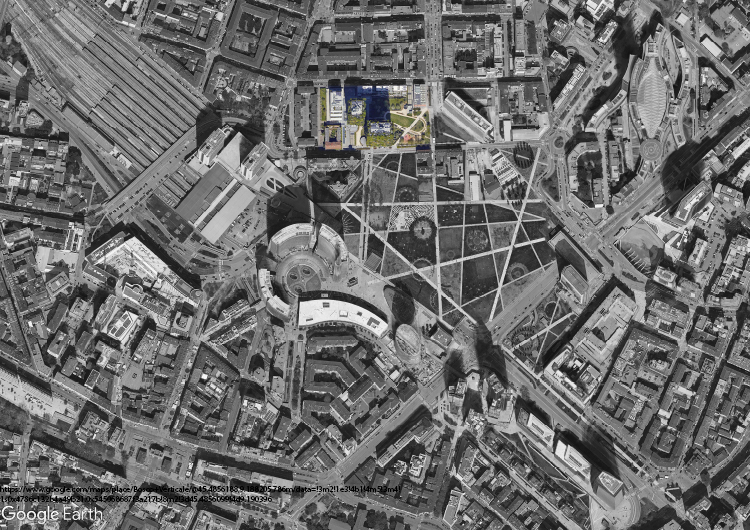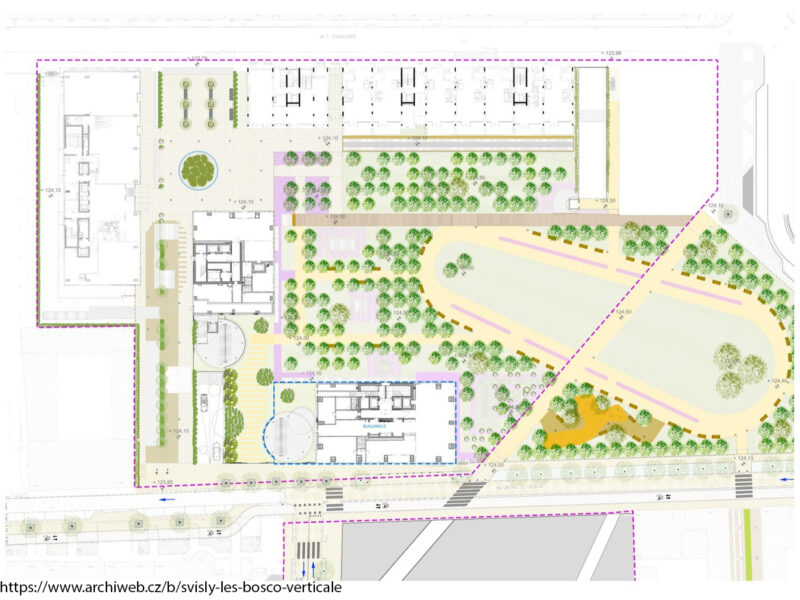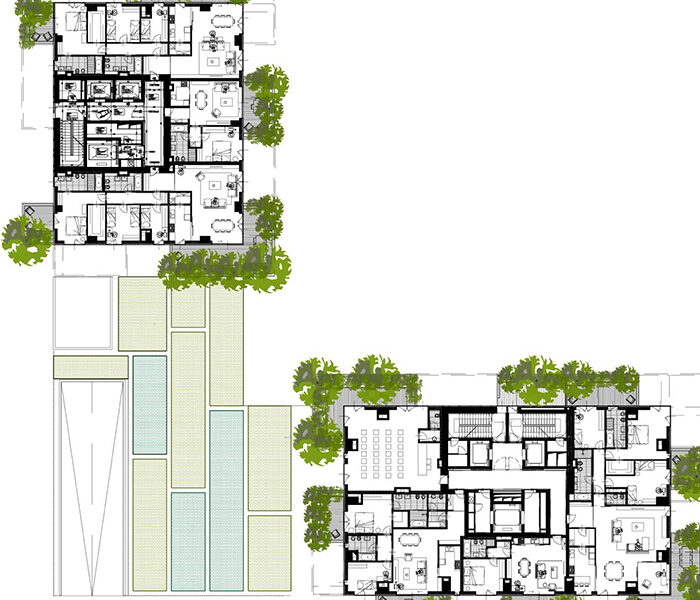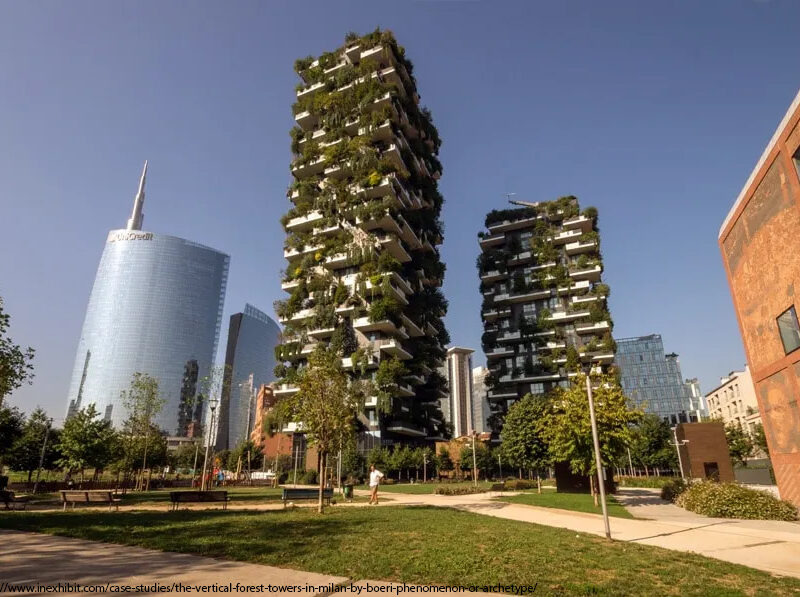Bosco Verticale







autorský popis projektu
zdroj: https://www.stefanoboeriarchitetti.net/project/bosco-verticale/em>
The Vertical Forest is the prototype building for a new format of architectural biodiversity which focuses not only on human beings but also on the relationship between humans and other living species. The first example, built in Milan in the Porta Nuova area, consists of two towers that are respectively 80 and 112 metres high, housing a total of 800 trees (480 first and second stage trees, 300 smaller ones, 15,000 perennials and/or ground covering plants and 5,000 shrubs, providing an amount of vegetation equivalent to 30,000 square metres of woodland and undergrowth, concentrated on 3,000 square metres of urban surface.The project is also a device for limiting the sprawl of cities brought about through a quest for greenery (each tower is equivalent to about 50,000 square metres of single-family houses). Unlike “mineral” facades in glass or stone, the plant-based shield does not reflect or magnify the sun’s rays but filters them thereby creating a welcoming internal microclimate without harmful effects on the environment. At the same time, the green curtain “regulates” humidity, produces oxygen and absorbs CO2and microparticles.
The concept behind the Vertical Forest, that of being a “home for trees that also houses humans and birds”, defines not only the urban and technological characteristics of the project but also the architectural language and its expressive qualities. On a formal level, the towers are mainly characterized by large, staggered and overhanging balconies (each about three metres), designed to accommodate large external tubs for vegetation and to allow the growth of larger trees without hindrance, even over three floors of the building. At the same time, the porcelain stoneware finish of the facades incorporates the typical brown colour of bark, evoking the image of a pair of gigantic trees in which to live and which are rich in literary and symbolic implications. The contrast with a series of elements in white stoneware – the stringcourses of the balconies and some modules on the front of the windowsills – introduces a syncopated rhythm in the composition which breaks up and “dematerializes” the visual compactness of the architectural bodies and amplifies the presence of the plants even more.
The variations in colour and shapes of the plants produce a tremendous iridescent landmark in every season and it is highly recognizable even at a distance. In just a few years this characteristic has resulted in the image of the Vertical Forest becoming a new symbol for Milan. This principle of variation also acts in relation to the different treatments applied on the sides of the towers and the various floors, where the choice and distribution of the plants and trees reflects both aesthetic and functional criteria applied in order to adapt to the direction and heights of the facades. The development of the botanical component, the result of three years of studies conducted together with a group of botanists and ethologists.
studentská recenze projektu
Patrik M. Berinšter ,01/2023 U6 2022 – Budoucnosti: Čas na změnu
Bosco Scepticale
Projekt Vertikálneho lesa talianskeho architekta Stefana Boeriho z roku 2014 výrazne rezonuje architektonickou aj laickou verejnosťou až do dnešních dní. Dve veže umiestnené v severnej časti Milána, v štvri mrakdorapov, sú už dnes považované za nový symbol mesta. Tak ako pri každom vizionárskom projekte, sme však nútení sa vysporiadať s istou dávkou skepticizmu a pochybností.
Veža, ako stabilizovaný architektonický typ reprezentujúci moc, vhodne vstupuje do Milánskeho panoramatu, ako predpoveď nového, sociálne-politického diskurzu, primárne orientovaného na transformáciu vzťahu medzi človekom a prírodou.
Daná forma adekvátne vedie dialog s architektonickými tendenciami súčastnosti: hustotou, minimalizáciou zastavanej plochy, maximalizáciu zelene, a.i..Boeri uvádza, že jeho veže sú ekvivaltenom 50 000m2 sprawlu, 20 000 m2 lesa, a to na 3000 m2 urbánnej plochy.
Projekt, vďaka minimálnej zastavanej ploche, vytvára v úrovni parteru nový park s veľkým množstvom atraktorov, ktoré by mohli aktivivať územie silno poznamenané monofunkčnosťou okolitých administratívnych veží.
Treba však uviesť zopár pochybností, ktoré pramenia z prezentácie projektu. Napriek všeobecnému naratívnu, že sa jedná o ekologicky projekt, ktorý razí cestu k novému, lepšiemu vzťahu medzi krajinou a architekturou, Boeri neuvádza v akom časovom horizonte jeho stavba vyrovná uhlíkovú stopu z výstavby, aké materiálove a konštrukčné riešenie je použité, odkiaľ stavba získava energie pre fungovanie systémov závlahy a samotnej stavby. Samotná stavba je poňatá ako železobetonová, čomu síce sme schopní porozumieť, vzhľadom na zvolený typ stavby v konvenčných projektech, je však otázne, prečo sa Boeri nevenoval taktiež výskumu použitia menej ekologicky náročných materiálov.
Zároveň je otázne, či je daný projekt replikovateľný, aby sa priblížil k Boeriho idei nového zeleného mesta. Obzvlášť v situácii, keď sme si vedomí nemalej finančnej investície Kataru a niekoľkoročnému výskumu, ktorý predchádzal realizácií. Ponúka sa otázka, či je daný, technokratický prístup, pri ktorom bol každý z 800 stromov samostatne šľachtený pre danú stavbu, vhodnou odpoveďou na našu súčastnú situáciu, alebo je to len obmena disporporčného vzťahu moderny k svetu, kde sa príroda musí podriadiť túžbam a ideám člověka.
odkazy a zdroje
odkazy a zdroje
zdroj informací:
zdroj informací:
https://www.archiweb.cz/b/svisly-les-bosco-verticale
zdroj informací:
https://www.architecture.com/awards-and-competitions-landing-page/awards/riba-international-awards/riba-international-awards-2018/2018/bosco-verticale
zdroj obrazové přílohy 1:
https://www.architecturaldigest.com/story/how-milans-bosco-verticale-has-changed-the-way-designers-think-about-sustainable-design
zdroj obrazové přílohy 2:
https://www.arup.com/projects/bosco-verticale
zdroj obrazové přílohy 3:
zdroj obrazové přílohy 4:
https://www.archdaily.com/777498/bosco-verticale-stefano-boeri-architetti
zdroj obrazové přílohy 5:
